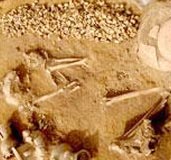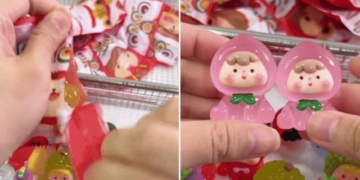The remains of a Persian woman who lived 3,000 years ago have been discovered buried alongside 600 pieces of an ancient gambling game. This is believed to be the earliest known female gambler.
 |
The bone fragments found in the grave of the Persian woman. |
Archaeologists unearthed the remains of the woman at Gohar Tepe in Mazandaran Province, Iran, near the Caspian Sea. The excavation is still ongoing, but it has yielded significant findings, including the woman associated with a game called Ghap, in which players juggle sheep bones.
“Many bone fragments were found in one grave, and with numerous pottery pieces surrounding them, it suggests the woman may have held a high status in society,” said Ali Mahforouzi, the head of the excavation.
The pieces of the game are all of the same size, indicating that the woman may have collected them as a hobby. The bone fragments also have holes drilled in them, suggesting they could have been used as jewelry, such as necklaces.
A pair of hair ornaments and two dress pins were also found on the woman’s chest. It is possible she was buried wearing a dress, with her hair concealed behind her back.
Shapour Suren-Pahlav, co-founder of the Circle of Ancient Iranian Studies educational program in the UK, expressed skepticism about the woman being a gambler. He stated that archaeologists have overlooked the historical context of the game Ghap and Ghap-bazi.
He elaborated: “Ghap-bazi was very popular among children in Iran, even until the late 1970s. It is possible that children placed the Ghap pieces in the grave as gifts for their mother or close relatives. However, that is merely a hypothesis, as there is no evidence to confirm the role of the Ghap pieces in the grave.”
Suren-Pahlav also added that the game may not be played in major cities in Iran anymore, but it still exists in small villages.
At the Gohar Tepe cemetery, researchers also found a pair of male and female remains from the Iron Age buried together in a joint grave. The condition of the bones and their positioning suggests they may have died suddenly in an accident.
Evidence of fabric from the same era was also discovered in a location that could have been an ancient textile shop. Fragments of collapsed ceiling tiles indicate that the structure fell during a fire, but no human remains were found inside.
3,000-year-old statues of humpbacked bulls were also excavated at Gohar Tepe. “One of the statues is remarkably intact. It has a shape that demonstrates the craftsmanship of its creator. The statue is finely sculpted and polished with cloth, giving it a shiny surface,” Mahforouzi mentioned. These statues may have been used in religious rituals, as cattle are still regarded as symbols of fertility and hard work.
The excavation at Gohar Tepe is expected to continue for another two months.
M.T. (according to Discovery)




















































